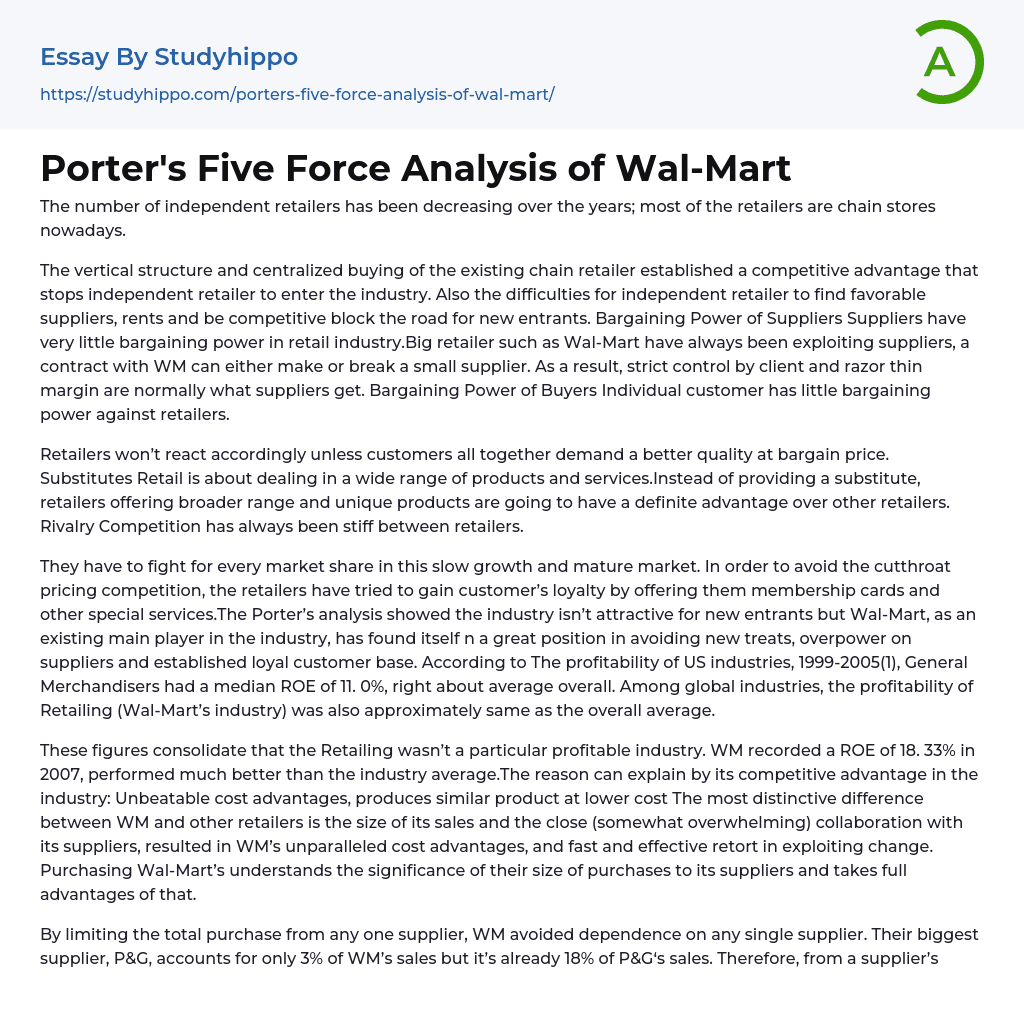The number of independent retailers has been decreasing over the years; most of the retailers are chain stores nowadays.
The vertical structure and centralized buying of the existing chain retailer established a competitive advantage that stops independent retailer to enter the industry. Also the difficulties for independent retailer to find favorable suppliers, rents and be competitive block the road for new entrants. Bargaining Power of Suppliers Suppliers have very little bargaining power in retail industry.Big retailer such as Wal-Mart have always been exploiting suppliers, a contract with WM can either make or break a small supplier. As a result, strict control by client and razor thin margin are normally what suppliers get. Bargaining Power of Buyers Individual customer has little bargaining power against retailers.
Retailers won’t react accordingly unless customers all together demand a better
...quality at bargain price. Substitutes Retail is about dealing in a wide range of products and services.Instead of providing a substitute, retailers offering broader range and unique products are going to have a definite advantage over other retailers. Rivalry Competition has always been stiff between retailers.
They have to fight for every market share in this slow growth and mature market. In order to avoid the cutthroat pricing competition, the retailers have tried to gain customer’s loyalty by offering them membership cards and other special services.The Porter’s analysis showed the industry isn’t attractive for new entrants but Wal-Mart, as an existing main player in the industry, has found itself n a great position in avoiding new treats, overpower on suppliers and established loyal customer base. According to The profitability of US industries, 1999-2005(1), General Merchandisers had a median ROE of
11. 0%, right about average overall. Among global industries, the profitability of Retailing (Wal-Mart’s industry) was also approximately same as the overall average.
These figures consolidate that the Retailing wasn’t a particular profitable industry. WM recorded a ROE of 18. 33% in 2007, performed much better than the industry average.The reason can explain by its competitive advantage in the industry: Unbeatable cost advantages, produces similar product at lower cost The most distinctive difference between WM and other retailers is the size of its sales and the close (somewhat overwhelming) collaboration with its suppliers, resulted in WM’s unparalleled cost advantages, and fast and effective retort in exploiting change. Purchasing Wal-Mart’s understands the significance of their size of purchases to its suppliers and takes full advantages of that.
By limiting the total purchase from any one supplier, WM avoided dependence on any single supplier. Their biggest supplier, P&G, accounts for only 3% of WM’s sales but it’s already 18% of P&G‘s sales. Therefore, from a supplier’s perspective, WM is last client they would want to lose. By making sure suppliers know “who’s in charge here”, WM then able to involve itself in its suppliers’ employment policies and convince the suppliers apply to adapt their way of doing business.Since early 90s, well before Internet was popularized, WM has kept close collaboration with its bigger suppliers using the electronic data interchange (EDI).
Nowadays suppliers can collaborate with WM’s forecast and schedule on inventories on individual stores, hence allowing a faster and tailored replenishment for every local WM stores. Distribution and warehousing. Wal-Mart was regarded as one of the leader in logistics for a reason. Firstly WM has its own distribution
centers that take care of 82% of WM’s purchases.
In terms of goods transportation, whilst most other retailers outsourced trucking, WM owned over 4000 trucks and is more efficient by having 60% of them full on backhaul to carry returned merchandise and pack up from local vendors. Other than packing their trucks tighter, WM continues to invent new distribution system to reduce inventories, speed deliveries to stores and eliminate stock-outs. As a result, WM’s inventories turnover were 7. 51% in 2008, lower compared to Target’s 5.
81% and Dollar General’s 4. 34%.Therefore WM has a higher flexibility Moreover, Wal-Mart started to import directly from overseas suppliers and sort out the imported products in its own new import distribution center in Texas in 2005. This prevented the delays and congestion of main ports, also further reduced WM’s dependency on suppliers hence WM can exert greater control over them. In conclusion Wal-Mart was very independent of its warehousing and distribution in many aspects.
Suppliers therefore had inconsequential bargaining power over Wal-Mart.
- Customer essays
- Customer Satisfaction essays
- Customer Service essays
- Target Market essays
- Atom essays
- Big Bang Theory essays
- Density essays
- Electricity essays
- Energy essays
- Force essays
- Heat essays
- Light essays
- Motion essays
- Nuclear Power essays
- Physiology essays
- Sound essays
- Speed essays
- Temperature essays
- Thermodynamics essays
- Accounting essays
- Andrew Carnegie essays
- Automation essays
- Business Cycle essays
- Business Intelligence essays
- Business Model essays
- Business Operations essays
- Business Software essays
- Cooperation essays
- Cooperative essays
- Corporate Social Responsibility essays
- Corporation essays
- Customer Relationship Management essays
- Family Business essays
- Franchising essays
- Harvard Business School essays
- Harvard university essays
- Human Resource Management essays
- Infrastructure essays
- Inventory essays
- Logistics essays
- Management essays
- Manufacturing essays
- Market essays
- Marketing essays
- Multinational Corporation essays
- News Media essays
- Online Shopping essays
- Quality Assurance essays
- Richard Branson essays
- Sales essays




